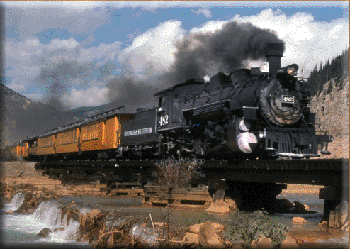| Silverton Magazine - Silverton, Colorado | ||
| Railroad | Burke's Custom Tours for Photographers & Artists | Silverton Magazine home page |
|
All content © San Juan Publishing Group, Inc, All rights reserved.  THE SAN JUAN MOUNTAINS were home to the Utes when gold was discovered in the early 1860s. Captain Charles Baker led a party into the broad, flat valley where Silverton now sits and discovered traces of gold. Although the Civil War took center stage during the period of 1860 to 1865, it was only a matter of time before the San Juans were crawling with prospectors. Negotiations with the Utes took several years, and in 1874 the San Juans were opened up to settlement. General William Jackson Palmer had arrived in Colorado with a vision of a north-south railroad from Mexico to connect with the transcontinental railroad already in the works. The Denver and Rio Grande Railroad was incorporated and quickly built lines south to Pueblo and Alamosa, Colo. News of great gold strikes in the San Juans drove Palmer to build a railroad to Silverton, the queen city of the San Juans.
THE SAN JUAN MOUNTAINS were home to the Utes when gold was discovered in the early 1860s. Captain Charles Baker led a party into the broad, flat valley where Silverton now sits and discovered traces of gold. Although the Civil War took center stage during the period of 1860 to 1865, it was only a matter of time before the San Juans were crawling with prospectors. Negotiations with the Utes took several years, and in 1874 the San Juans were opened up to settlement. General William Jackson Palmer had arrived in Colorado with a vision of a north-south railroad from Mexico to connect with the transcontinental railroad already in the works. The Denver and Rio Grande Railroad was incorporated and quickly built lines south to Pueblo and Alamosa, Colo. News of great gold strikes in the San Juans drove Palmer to build a railroad to Silverton, the queen city of the San Juans. With the arrival of the Denver & Rio Grande Railroad to Silverton in 1882, ore was easily exported, and supplies were easier to get. Silverton was the center of commerce for the region—you could buy anything from a top hat and cigar to dynamite and blasting wire. Soon other entrepreneurs followed—men like Otto Mears, the "Pathfinder of the San Juans" who built railroads further into the mountains to make it easier to get their riches out. Durango became a smelter town—rich ores mined and milled at mines like the Sunnyside, the Old Hundred and the Silver Lake were now shipped south to be smelted. Agricultural towns like Bayfield and Mancos grew up around Durango to serve as suppliers to the rough and tumble mining towns to the north In the years since, several of the boom and bust cycles typical of the mining industry happened, making fortunes and then sending them plummeting. The boom cycles saw an influx of people from every ethnic group on earth, and the bust cycles saw towns turn into ghostly reminders of themselves. Today Silverton is the only town left in San Juan County, with a population of 500, supported by tourists who ride the rails to see the magnificent scenery and experience the incredible history of the area. . Photographs Silverton Train approaching Silverton. ©James Burke for San Juan Publishing |
| The Silverton Magazine. Copyright 2000-2010 Published by San Juan Publishing Group, Inc., Colorado No part of this publication may be reproduced in any means whatsoever without written authorization from SJPG. (Plagerizers will be hung from the yardarm and fed to the mountain sharks!) Queries for re-print rights, email [email protected] |
Copyright San Juan Publishing Group, Inc. Web design by Kathryn R Burke
